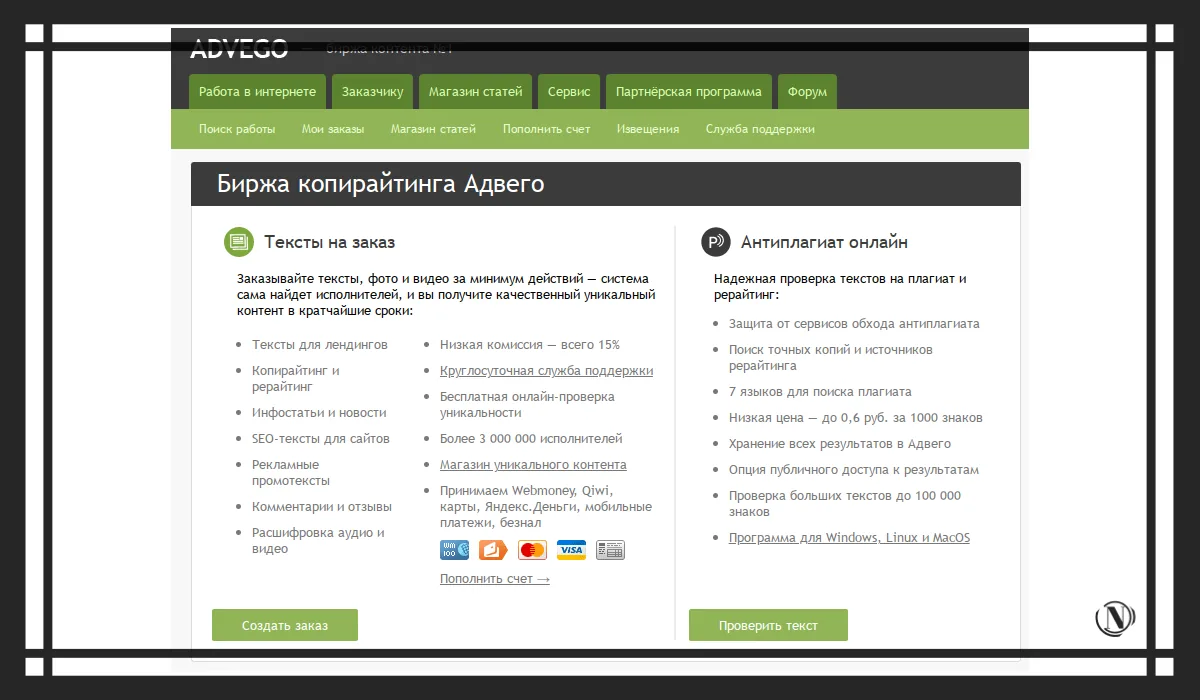Water content in SEO: what it is and how to reduce it
 water in text (water content of the text) is the number of words and phrases that do not carry a semantic load and do not benefit the user. The higher the water content of the text, the lower the quality of the content, which may affect the ranking in search engines.
water in text (water content of the text) is the number of words and phrases that do not carry a semantic load and do not benefit the user. The higher the water content of the text, the lower the quality of the content, which may affect the ranking in search engines.
Therefore, understanding how to avoid the use of redundant words and phrases, as well as how to reduce the amount of water in the text, is a priority for the SEO specialist and copywriter.
In this article, we will look not only at what are considered stop words, but also what words and phrases should be excluded from the text, as well as how to improve the quality and understandability of the text. We'll also take a look at popular text water content checkers and explain how they can help improve content.
Finally, let's discuss how text content affects search engine rankings and how to avoid negative impact of this factor on SEO.
Read on to find out how to improve your content and increase your search engine rankings!
The content of the article:
- What is text water content?
- What percentage of water in the text is considered acceptable?
- What words are considered stop words?
- Why remove water from text?
- How to reduce text water content?
- Services for checking the water content of the text
- Influence of water content of texts on ranking in search engines
- Conclusion
- FAQ
What is the water content of the text
 Water content of the text - this is the number of words and phrases that do not carry a semantic load and do not bring benefits to the user. As a rule, these are linking words, pronouns, particles, prepositions and other words that do not provide information about the topic of the text.
Water content of the text - this is the number of words and phrases that do not carry a semantic load and do not bring benefits to the user. As a rule, these are linking words, pronouns, particles, prepositions and other words that do not provide information about the topic of the text.
Such a “water” can negatively affect search engine rankings, as search algorithms are designed to show the user only the most useful and relevant information. High water content can degrade the user experience because it makes text difficult to understand, less readable, and prevents quick access to relevant information.
Therefore, in order to optimize content and improve its ranking in search engines, it is necessary to avoid redundant words and phrases, as well as monitor the quality of the text as a whole. This may include reworking the text to remove excess water, using specific and descriptive phrases, and breaking up the text into small chunks using headings and lists.
However, words such as prepositions and pronouns should not be completely avoided, as they can play a significant role in the structure of the text and increase its readability. It is important to find a balance between the clarity of the text and its quality in terms of SEO.
What percentage of water in the text is considered acceptable?
 The allowable percentage of water in the text is the number of words that do not carry a semantic load that can be in the text without negatively affecting its quality and SEO performance. It is impossible to determine the exact percentage of acceptable water content for all texts, since it depends on the specific content and its target audience. However, in general, the percentage of water should not exceed 30%, and the range from 10% to 20% is considered optimal. The critical threshold is 50%, at which the risk of losing content quality and ranking in search engines increases significantly.
The allowable percentage of water in the text is the number of words that do not carry a semantic load that can be in the text without negatively affecting its quality and SEO performance. It is impossible to determine the exact percentage of acceptable water content for all texts, since it depends on the specific content and its target audience. However, in general, the percentage of water should not exceed 30%, and the range from 10% to 20% is considered optimal. The critical threshold is 50%, at which the risk of losing content quality and ranking in search engines increases significantly.
What words are considered stop words
Stop words - these are words that do not carry specific information and do not play a role in the context of the text. They include commonly used words in the language, such as prepositions, conjunctions, pronouns, particles, and other auxiliary words.
Eliminating stop words from text can help improve its quality and readability, as it allows you to focus on the necessary words and expressive means. At the same time, it is necessary to be careful and avoid deleting words that are indispensable for the context and content of the text.
Some of the commonly used stop words in English include:
- a, an, the
- and, or, but
- in, on, at
- of, to, for
- is, are, am
- I, you, he, she, it, we, they
In Russian, stop words also include frequent prepositions, conjunctions, and pronouns, such as:
- and, or, but
- in, on, oh, about, at
- from, from, to
- I, you, he, she, it, we, you, they
Despite the fact that these words do not carry information, they can play a significant role in the structure of the sentence and the context of the text. Therefore, when removing stop words from the text, you need to make sure that this does not affect the understanding of the text and its logical connection. In general, removing stop words from text is one way to improve its quality and relevance to users and search engines.
Why remove water from text?
Removing water from text is a paramount step in optimizing content for search engines and improving user experience. When text contains a lot of water, it makes it difficult to understand its content and can lead to poor search engine rankings.
One way to improve text clarity is to remove repetitive phrases, words, and stop words that add no value to the content. This allows the text to be clear and concise, which improves the perception and assimilation of information by the reader.
In addition, reducing text water content helps improve content quality. Content with low water content has more information, which can attract more users and improve search engine rankings.
Removing water can also help speed up page loading. The smaller the amount of text, the faster the page loads, which is important for improving the user experience and keeping visitors on the site.
How to reduce text water content
There are several ways to help reduce the amount of water in the text and make it informative and useful for users and search engines.
- Use synonyms to avoid repetition. Using different words and phrases can help improve the quality of the content and add new information.
- Remove stop words that are of no value to the text. Stopword examples: “also”, “besides”, “for example”, “generally”, “obviously”, “as is known” and others.
- Use an active voice that adds a dynamic and concise tone to the text. For example, instead of “it was decided to make changes” you can write “we decided to change”.
- Avoid using redundant words and phrases that do not carry additional information and may increase the water content of the text. Examples of such phrases: “in connection with this”, “usually”, “in most cases”, “certainly”.
It is important to remember that removing unnecessary words should not lead to a loss of meaning of the text or a decrease in the quality of the content. Each word should carry informational value and be included in the text only when necessary.
Services for checking the water content of the text
Checking the water content of the text is an essential stage of content optimization for successful work in SEO. There are many online services that will help you evaluate the water content of the text. Some of the most popular of these tools are:
- Advego is one of the simple and popular services that supports many languages and allows you to show the semantic core of the text, as well as the percentage of each stop word and their frequency in percent.

- Text.ru, in turn, provides a detailed result and separates words into groups, which is very convenient. However, this service has disadvantages, such as slow work and blocking the water test if you check a lot of materials, so you need to take breaks for 10-15 minutes.

- Istio is a service for checking the water content of the text, which allows you to control by various parameters without re-inserting the material into the input form. But there is a minus - an unfinished algorithm for calculating stop words, which often leads to underestimated results when analyzing texts for water.

- Glavred, in turn, helps to bring the text under the TOR of the most demanding SEO-optimizers, emphasizing all the problem fragments. However, the service does not have detailed statistics on stop words, and the rating is set on a 10-point scale, so it will not be possible to obtain information in percentage terms.

It is important to understand that these services can be useful not only for assessing the water content of a text, but also for identifying other problems, such as low uniqueness or errors in grammar and spelling. To use these services to reduce the water content of the text, you must enter the text in the appropriate field, select the language and click the “analyze“.
After analyzing the text, the services will provide detailed information about the water content of the text, as well as offer recommendations for improving the quality of the text and reducing water content. Using such tools will allow you to create useful and optimized content that will attract more traffic to the site and improve search engine rankings.
Influence of water content of texts on ranking in search engines
Water in text can have a negative effect on SEO, which can lead to lower search engine rankings. However, this does not mean that certain words and phrases should be avoided. Instead, you should pay attention to the fact that the number of repetitions of keywords in the text should be acceptable.
Too many repetitions of keywords can be perceived by search engines as an attempt to deceive their algorithms. To avoid the negative impact of high text content on rankings, it is recommended to use synonyms and related terms. It will also help make the text interesting and useful for readers.
To determine the water content of the text, you can use various tools that show the percentage of water content and the number of repetitions of stop words. Using such tools can help improve text quality and avoid negative ranking effects.
Finally, it should be remembered that in SEO optimization, not only the content of the text is important, but also its quality. Therefore, when writing texts, attention should be paid not only to the use of keywords, but also to the quality of the content that will be offered to readers.
Conclusion
In conclusion, text content is a serious aspect of SEO and can affect search engine rankings. When creating content, it is necessary to take into account both high-quality preparation and the water content of the text in order to avoid a negative impact on the site's rating.
To reduce water content, use techniques such as removing repeated words and phrases, replacing synonyms, and using complex sentence structures. It is important not to forget about the readability of the text and its semantic load.
It is also worth paying attention to the use of stop words and their percentage in the text, as they can significantly increase the water content of the text. It should also be taken into account that text optimization for water content should be carried out in combination with other factors such as uniqueness, relevance and content quality.
In general, reducing the water content of a text is a complex process that requires careful analysis and certain skills. However, by following the guidelines above, you can increase the usefulness of your content and improve search engine rankings.
FAQ
Q: What is the water content of the text?
A: The water content of the text is the number of words that do not carry a semantic load and do not improve the quality of the text.
What is the percentage of water in the text?
The percentage of water in the text is the number of words that do not carry a semantic load and are only necessary to form the structure of the text.
What percentage of water in the text is considered acceptable?
A: It is considered that the allowable percentage of water in the text is from 5 to 20%.
Q: What words are considered stop words?
A: Stop words are common words in the language such as “and”, “in”, “on”, “not”, “what”, etc. Including prepositions, conjunctions, pronouns and particles.
Why remove water from text?
Removing water from text improves its quality and understandability, makes it more relevant, and increases the likelihood that search engines will rank it higher.
Q: How to reduce the water content of the text?
To reduce the water content of the text, it is necessary to remove stop words and avoid repeating the same or similar phrases. It is also worth using more specific and informative words that accurately convey the meaning of the text.
Q: What are the services for checking the water content of the text?
Some of the popular services for checking text water content include Advego, Text.ru, Istio, and Glavred.
Q: What effect does text content have on search engine rankings?
Text water content can have a negative impact on search engine rankings as it can reduce text quality and relevance. Removing water from text can increase its quality and increase the likelihood that search engines will rank it higher.
Reading this article:
Thanks for reading: SEO HELPER | NICOLA.TOP













